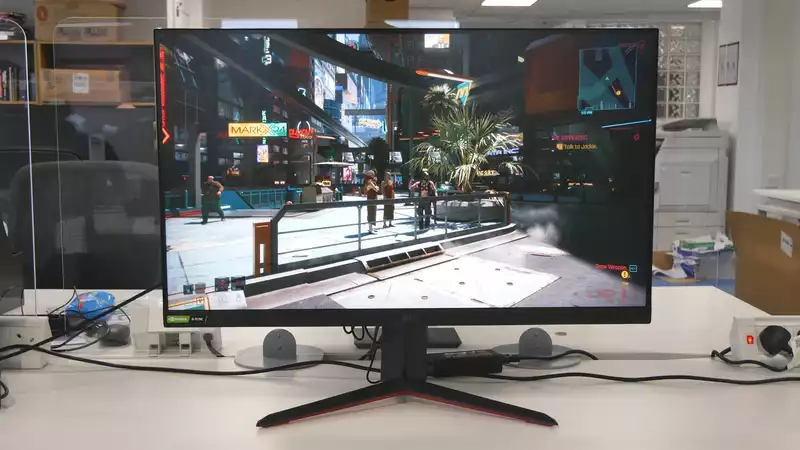The new LG UltraGear 32GP850-B gaming monitor is the perfect compromise between frame rate, performance, and graphic detail. There are faster screens with higher refresh rates. There are panels with more pixels. Some monitors span more inches. But LG's latest model looks pretty compelling as an all-around, on-paper gaming proposition.
The basic recipe is a 32-inch high-speed IPS panel with a 1ms response time, 180Hz refresh rate, and 2,560 x 1,440 pixels. There has been a lot of noise recently about high-refresh 4K gaming, including the new generation of consoles from Microsoft and Sony. But the LG UltraGear's 32GP850-B's combination of 1440p and 180Hz is certainly more suitable for most PC gamers.
First, it is not only a more affordable monitor. It also halves the chances of achieving frame rates above 100 fps with a GPU that can afford it. 4K@144Hz is certainly impressive. But in the current climate of unusually high graphics card prices and limited availability, such a display would be difficult to drive properly.
At the same time, 2,560 x 1,440 pixels provides a decent level of graphic detail in games. Certainly, the same cannot be said for desktops, especially given that this is a 32" panel rather than the more common 27" 1440p; the 92 DPI pixel density is by no means impressive, and the 2,560 x 1,440 pixel resolution is not as impressive as it should be. In short, the core of this panel's appeal lies in the balance between gaming and general computing priorities.
This basic conundrum aside, the LG UltraGear 32GP850-B has a broad feature set that is powerful but hardly comprehensive. On top of that, its 1ms pixel response is real gray-to-gray, not the generally unreliable MPRT metric. It is also AMD FreeSync Premium certified and Nvidia G-Sync compatible. Thus, it is a good idea to use adaptive refresh regardless of the graphics card you choose.
LG also claims 98% coverage of the digital cinema DCI-P3 color space from its IPS panel The LG UltraGear 32GP850-B is not just fast. It is also a precision instrument. As for design and engineering, it's a fairly sleek-looking customer with slim bezels and a stand that can be heightened, tilted, and rotated in portrait mode. Only swivels are not supported, so the entire monitor must be physically rotated.
If there is a clear weakness, it is HDR performance: decoding of HDR10 signals is supported, allowing you to watch HDR video, play HDR games, and see the correct colors. However, there is no VESA HDR certification, and the maximum brightness is a relatively modest 350 nits. Similarly, the IPS panel's static contrast is low at 700:1, which won't help you express high peaks and deep valleys at the same time. [The LG UltraGear 32GP850-B is not the punchiest or most vibrant gaming panel we've seen. Moderate backlight power and mediocre contrast performance don't help. There's also a tiny bit of the old IPS sparkle, resulting in a somewhat watery, weak image overall.
Not surprisingly, HDR content is unimpressive. Would a game like Cyberpunk 2077 look better in HDR mode than in SDR on the LG UltraGear 32GP850-B? But on a monitor with true HDR capabilities, it is a much closer call than it should or would be.
That said, the colors are accurate and it is not a bad display per se. In fact, one quickly becomes accustomed to the somewhat subdued image quality. However, it is not the rich, vivid experience that you get with most modern IPS monitors, let alone VA monitors with cutting-edge features such as full arrays, micro-LED local dimming, etc.
More impressive, however, is the speed of the LG UltraGear 32GP850-B. LG has added the ability to set three levels of pixel overdrive in the OSD menu. The middle setting provides a really quick response with very little overshoot. If you have a fairly fast GPU, 180Hz refresh provides ultra-low latency. As a side note, full 180Hz is only accessible via the "overclock" toggle in the OSD menu, which is a rather silly and cumbersome gimmick that I hope monitor manufacturers do not bother with. This is a 180 Hz monitor, so "overclocking" is ridiculous.
Access to the full 180Hz is only possible via the LG UltraGear 32GP850-B's single DisplayPort 1.4 interface; the two HDMI ports are limited to 144Hz, and the monitor is only capable of displaying video at 180Hz. Considering that you can only get 120Hz at best on any gaming console, that may be okay. In any case, this monitor would be an appropriate choice in the long run in terms of sharing access between the gaming PC and the console. Remember that Microsoft's Xbox Series X already supports 1440p, while Sony's PS5 is still waiting for support.
Overall, the summary is that this is a very fast and very sharp panel, with adequate graphic detail and accurate but unobtrusive image quality. It's a great package for the price, although I wish the IPS panel had a little more punch when it comes to brightness and contrast.
.

Comments